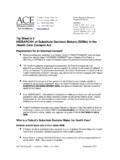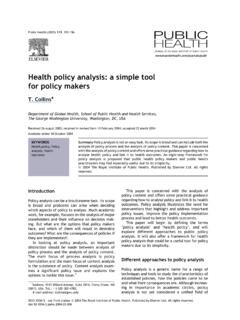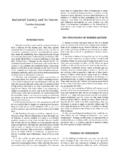Transcription of Environmental Taxation - OECD
1 September 2011 1 Environmental Taxation A Guide for Policy makers This guide is based on the OECD s recently issued book Taxation , Innovation and the Environment. Overview Environmental challenges are increasing the pressure on governments to find ways to reduce Environmental damage while minimising harm to economic growth. Governments have a range of tools at their disposal, including regulations, information programmes, innovation policies, Environmental subsidies and Environmental taxes. Taxes in particular are a key part of this toolkit. Environmental taxes have many important advantages, such as Environmental effectiveness, economic efficiency, the ability to raise public revenue, and transparency. Also, Environmental taxes have been successfully used to address a wide range of issues including waste disposal, water pollution and air emissions.
2 Regardless of the policy area, the design of Environmental taxes and political economy considerations in their implementation are crucial determinants of their overall success. This policy guide has a few key messages: Why use Environmental taxes? Taxes can directly address the failure of markets to take Environmental impacts into account by incorporating these impacts into prices. Environmental pricing through Taxation leaves consumers and businesses the flexibility to determine how best to reduce their Environmental footprint . This enables lowest-cost solutions, provides an incentive for innovation and minimises the need for government to attempt to pick winners . How to design Environmental taxes? Environmental tax bases should be targeted to the pollutant or polluting behaviour, with few (if any) exceptions.
3 The scope of an Environmental tax should ideally be as broad as the scope of the Environmental damage. The tax rate should be commensurate with the Environmental damage. The tax must be credible and its rate predictable in order to motivate Environmental improvements. Environmental tax revenues can assist fiscal consolidation or help to reduce other taxes. Distributional impacts can, and generally should, be addressed through other policy instruments. Competitiveness concerns need to be carefully assessed; coordination and transitional relief can be effective responses. Clear communication is critical to public acceptance of Environmental Taxation . Environmental taxes may need to be combined with other policy instruments to address certain issues. The rest of this guide develops these points in greater detail.
4 September 2011 2 Why use Environmental taxes? Without government intervention, there is no market incentive for firms and households to take into account Environmental damage, since its impact is spread across many people and it has little or no direct cost to the polluter. Therefore, protection of the environment generally requires collective action, usually led by government. In the past, Environmental policy was typically dominated by command-and-control regulations. These approaches were generally prescriptive and highly targeted , banning or limiting particular substances or requiring certain industries to use specific technologies. Over recent decades, interest has grown in using market-based instruments such as taxes and tradable emission permits. There are a number of reasons for the increasing use of Environmental taxes.
5 Taxes directly address the market failure by pricing in Environmental costs Taxes directly address the market failure that causes markets to ignore Environmental impacts. A well-designed Environmental tax increases the price of a good or activity to reflect the cost of the Environmental harm that it imposes on others. The cost of the harm to others an externality is thereby internalised into market prices. This ensures that consumers and firms take these costs into account in their decisions. Taxes leave consumers and businesses with flexibility to determine the least-cost way to reduce the Environmental damage Most regulatory approaches involve the government specifying how to reduce emissions or who should do the reduction. Similarly, subsidies and incentives for environmentally preferable goods or practices involve the government steering the economy in favour of certain Environmental solutions over others.
6 Both approaches involve the government trying to pick winners directing the market in a prescriptive way. This requires significant information about ever-changing conditions and technologies, and carries significant risk of making suboptimal choices. Regulations generally result in higher costs than taxes, since they force particular types of abatement, even if cheaper alternatives are available. The higher cost of the polluting activity that results from the Environmental tax makes the activity less attractive to consumers and businesses. In contrast to regulations or subsidies, however, a tax leaves consumers and businesses full flexibility to decide how to change their behaviour and reduce the harmful activity. This allows market forces to determine the least-cost way to reduce Environmental damage.
7 For example, many countries impose significant taxes on motor fuels like petrol and diesel because their use contributes to global warming and local air pollution. The resulting increase in the cost of driving a vehicle is an incentive to reduce emissions that could be achieved in a number of ways, in both the short-term and the long-term: Drive a smaller or otherwise more fuel-efficient vehicle. Drive a vehicle that uses a lower-emission power source, such as a hybrid-electric vehicle. Drive less, perhaps by greater use of low- or no-emission alternatives like public transit, cycling, walking, living closer to the place of work, or otherwise changing habits to reduce the need to travel. The Environmental tax provides a greater range of abatement options than instruments such as a regulation requiring a minimum fuel efficiency level for vehicles or a subsidy that privileges electric vehicles, which target only some solutions.
8 Of course, if regulations are tough enough and strictly enforced, they can have significant effects. However, this achievement may be bought at the expense of unnecessarily high costs. September 2011 3 The flexibility of response associated with Environmental taxes also provides other benefits: Ongoing incentive to abate. A target-based or technology-based regulation provides no incentive to abate once the target or technology standard is met. By contrast, Environmental taxes provide a continuous incentive to abate at all levels of emissions, even after significant abatement has already occurred. Improves competitiveness of low-emission alternatives. Environmental taxes increase demand for low-emission alternatives, like public transit and cycling in the case of taxes on automotive fuel.
9 This results in economies of scale that help to make such alternatives more viable, without a need for direct subsidies. Strong incentive to innovate. Taxes increase the cost to a polluter of generating pollution, providing incentives for firms to develop new innovations and to adopt existing ones. For example, in the example above, the increased demand for more fuel-efficient and alternatively powered vehicles induced by fossil fuel taxes provides an important incentive for automakers to develop such vehicles and for consumers to adopt them. Under regulation-based approaches these incentives disappear once firms have complied with the regulated standard. Enhanced innovation lowers the cost to society of addressing Environmental challenges in the long run.
10 (This issue is further discussed in the related OECD brief Taxation , Innovation and the Environment A Policy Brief .) Environmental taxes also have other important features: Transparency. Well-designed taxes are highly transparent in terms of their coverage and costs. It is generally clear what is taxed, which polluters are exempt, and what the cost to polluters will be per unit of pollution generated. By contrast, the impact of regulations on different firms is typically more difficult to discern, and preferential policies for particular industries or constituencies can be harder to identify. Cost certainty vs. Environmental certainty. Environmental taxes increase the cost of particular products and activities in a fairly direct and generally predictable way.



















